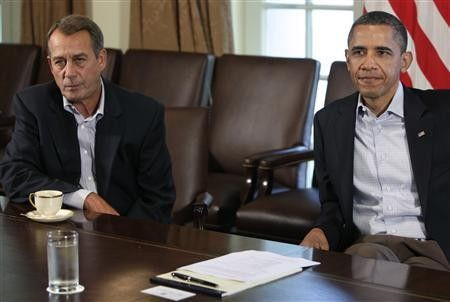Insight: Washington crippled after long road to deadlock

Paul Light has worked in and studied the institutions of government in Washington for more than three decades. He has written papers and taught about the great American legislative battles of modern times, where compromise has nearly always prevailed.
But on the issue of the extraordinary gridlock in Washington today, where Congress and the White House appear unable to act on the critical need to raise the government's $14.3 trillion debt ceiling and avert a catastrophic default, Light is stunned.
"I've never never seen a breakdown like this," he said. "This is a defining moment in America's inability to act."
Many observers of the debt limit crisis are dumbfounded by the failure of America's leaders to strike a deal of such manifest importance to the global economy.
Without agreement to raise the borrowing cap by August 2, the United States will run out of money to pay its bills, triggering market chaos and soaring interest rates, casting a pall over global economic growth.
The explanation lies in a confluence of events that have been decades in the making, a perfect storm of gerrymandering, spending, partisanship and recession that has destroyed the political center, robbed Washington of patriotic deal-makers and led to what many analysts believe is the most dysfunctional U.S. Congress of the modern era.
One major factor behind the gridlock is redistricting. Most countries, including the United States, adjust their electoral boundaries to reflect population changes.
Most countries give this job to independent commissions. In the United States, the political party that controls state legislatures redraws the maps.
To make sure as many congressmen from their own party are elected to Congress, state politicians have created safer and safer seats by making them as homogenous as possible.
MODERATES VANISHING
As a result, after years of gerrymandering -- a word derived from the redrawing of Massachusetts state senate seats in 1812 by then governor Elbridge Gerry -- in the majority of congressional races independents and voters from the opposition party have been shut out. The most partisan and extreme candidate is the one who usually wins.
"Redistricting has made a tiny slice of ideological activists the power brokers in who gets sent to Congress," said Norm Ornstein, a congressional scholar at the conservative-leaning American Enterprise Institute.
As a result, the political center in Congress has been eviscerated. Moderate deal-makers are rare. In 1970, 33 percent of members of Congress were considered moderates, based on their voting records, according to James Thurber of American University's Center for Congressional and Presidential Studies.
In 2011, that figure stands at 5 percent.
Ornstein also points to the seismic shift in political geography over the past 50 years. The South used to be dominated by conservative Democrats. Today it is a bastion of conservative Republicans.
The Northeast after World War Two was dominated by moderate Republicans. Today it is heavily Democratic.
"So the Democratic Party became more homogenous and moved left, and the Republican Party became much more homogenous and moved sharply right," Ornstein said.
Members of Congress from both parties used to socialize. They would play golf, drink together, build friendships and trust -- crucial bonds when deals of this magnitude needed to be struck.
DEALMAKERS GONE
Ronald Reagan, a Republican president, and Tip O'Neill, the Democratic House speaker, would hurl invective at each other by day and share a whisky in the evening. Together, they forged a deal to reform Social Security in 1983, a compromise unthinkable today.
To deal with deficits, Reagan also raised taxes 11 times while president -- something today's Republican Party would view as heresy.
"Leaders then were able to override the political interests of the rank-and-file and act in the best interests of the country. I do not see that today," Light said.
Crucially, party leaders also had control of their caucuses and could deliver votes.
Today, John Boehner, the Republican House Speaker, saw his efforts to craft a $4 trillion debt limit "grand bargain" with President Barack Obama sabotaged by his ambitious and conservative deputy Eric Cantor.
Cantor refused to oppose the anti-tax war cry of new House members affiliated with the fiscally conservative Tea Party movement.
"The Tea Party folk believe they have been lied to by Republicans and Democrats for years and they have drawn a line in the sand," said political analyst Stu Rothenberg.
"They don't trust the institutions of Washington. They do not believe in compromise."
Such is the growing power of the Tea Party, that many Republicans in the House -- who face reelection every two years -- will not oppose them for fear of receiving a Tea Party primary challenge next year.
TRUE FISCAL PROBLEM
Today's national debt -- the total amount the U.S. government has borrowed over time --is another issue. At $14.3 trillion, it is so big that it would be difficult to compromise on even in normal times.
In 2000, at the beginning of Republican George W. Bush's presidency, it was $5.7 trillion, according to the U.S. Treasury Department -- a time when the United States also had a projected surplus of $5.6 trillion over 10 years.
Since then, there have been two wars, tax cuts, a recession, a Wall Street bailout and Obama's stimulus spending.
"The sheer size of the debt has increased the polarization because it's intensified the view of Republicans that the government is out of control, and it has made divisions about what the role of government should be even more stark," said David Gergen, a political analyst who has advised four U.S. presidents.
© Copyright Thomson Reuters 2024. All rights reserved.





















